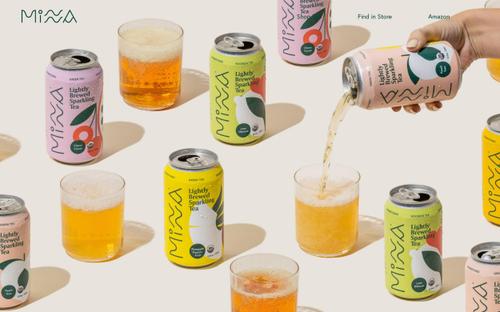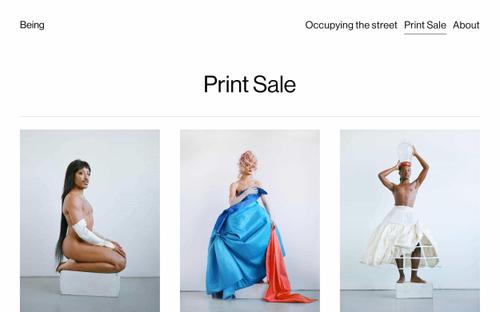Download a free workbook to help you design your site with confidence.
The email you entered is invalid.
Thank you for subscribing.
By entering your email, you indicate that you have read and understood our Privacy Policy and agree to receive marketing from Squarespace.
A landing page is just that—the web page site visitors land on when they navigate to your website. For many people, that’s the homepage. But depending on what the most important pages on your site, your landing page could be a list of services, your shop, or a booking page. In some cases, you might have a landing page for a specific marketing campaign or product.
The key to a great landing page is a design that makes it clear what the next step is for your visitor, whether that’s making a purchase, signing up with an email, or gathering information. Here are 7 examples of different landing pages and use cases to inspire your own.
What makes a great landing page?
The most effective landing pages are clear, focused, and designed to encourage conversion via clicks, signups, or purchases. Keep these best practices in mind when designing your landing page.
Have a specific goal. Knowing what you want to communicate to a visitor and what you want them to do will focus your ideas and design.
Know your target audience. Understanding what matters to your site visitors will help you address those points in your landing page copy.
Include proof points. Whether it’s data, photos, or customer reviews and testimonials, highlight the value of your product or service to the visitor.
Use design to draw attention. Use bold colors and fonts or placement on your landing page to ensure someone is drawn to your call to action or important details.
Have a backup plan. While there’s one goal you have in mind for your visitors, think of where else you could send someone who’s not ready to take action yet. Make sure it’s easy for them to reach that point
See more tips for landing page design
1. Service landing page: Hair salon
This services page for a hair salon is simple, to the point, and easy to navigate. This makes it an ideal landing page for the salon or individual stylists to link to in social media posts and emails to potential clients.
The image helps create balance on the page, but it’s not distracting from the most important details. There’s clear pricing, and it’s obvious how a site visitor can make a booking using the “Book appointment” button in the navigation bar—the ideal next step. Or they can keep browsing if they want to see more stylists and other details.
2. Ecommerce landing page: Florist
Your online store page is one of the best landing pages to send potential customers to. A well-organized store landing page can give shoppers a quick overview of your pricing and what you sell to help them quickly find something they’re interested in buying.
In this example, you can quickly browse what the floral shop offers or filter between full arrangements and vase-less bouquets. Beautiful product photos make the value and quality of the business clear. It’s easy to make a choice and purchase from there.
3. Reservation landing page: Restaurant
The landing page you choose to link depends on context. For example, this food business might link social media followers to a reservations landing page from a post showing off their new summer menu. But when speaking to people who are newer to the restaurant, the homepage or menu page might be a better landing page to link.
The reservations page design does an effective job of pointing visitors to the most important action: clicking that Book Now button. But it also includes design choices, like an animated squiggle, bold font, and bright colors, that communicate the personality of the restaurant.
4. Sign-up landing page: Community group
A landing page doesn’t have to be part of a multi-page website. For community groups or bigger businesses, a landing page is a dedicated place to send people when marketing a specific thing.
In this website example, an athletic community is encouraging anyone interested to get in touch with a straightforward call to action. This allows the group to build a contact list and create a space for potential members while maintaining a separate space for active members.
5. Homepage landing page: Pet store
For many people, the most visited landing page you have will be your website’s homepage. Your homepage will naturally have more information on it than a standalone landing page, but keep it focused to make sure you’re directing visitors to important pages or encouraging them to convert.
This example website does a good job of letting visitors know what the business sells and creating a sense of excitement around their product. The headline captures the viewer and the next section on the page highlights the product and links to shop—the top goal of the business. But if someone isn’t ready to buy, the page follows with reviews and options to stay connected via social media or email.
6. Homepage landing page: Beauty and wellness
This example of a homepage landing page focuses on a design for a store that might need to educate potential customers before they decide to buy. Whereas pet owners might have a sense of what they want out of accessories for their pets and how to identify them in a product listing, that’s harder for a body care product.
On this landing page, the business puts more products on display and highlights the benefits for each category. Instead of linking to social media on the homepage, they focus on their research and mission, to build trust with their potential customers.
7. Event landing page: Party RSVP
An event is a perfect opportunity to use a landing page. The landing page gives you one central place to share information about your event and collect RSVPs. Whether it’s part of your website or a standalone site, having a dedicated page also makes it easier to discover.
You can edit the page as your event develops, first building excitement with a simple page teasing the event, then revealing more details closer to the event date. Add a custom form to collect RSVPs, food and drink preferences, or other requests from your guests.
This article was updated on March 19, 2025.










